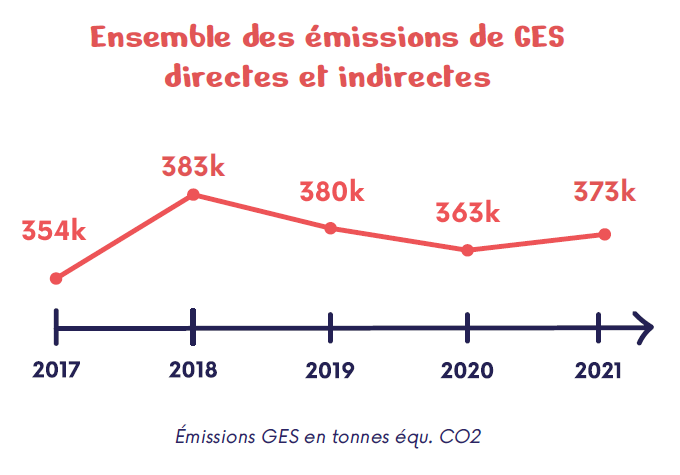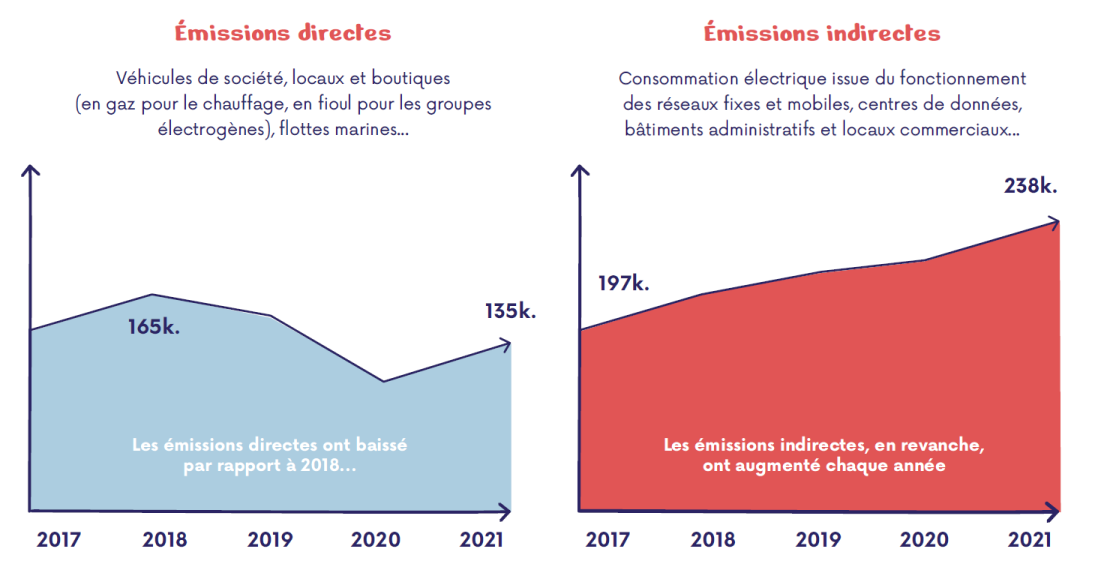In this second edition of its annual inquiry into “Achieving digital sustainability”, Arcep is publishing the indicators collected from France’s four main telecoms operators, to track the evolution of their environmental footprint from 2017 to 2021.
The four main electronic communications operators’greenhouse gas emissions increased in 2021 after two years of decrease, while remaining below 2019 levels
The four main electronic communications operators’ greenhouse gas emissions rose by 3% in 2021 compared to 2020, reaching 373,000 tonnes of Co2 equivalent.
This increase can be attributed to the sizeable rise (+ 4% in 2021) in direct greenhouse gas emissions after two years of decrease, and the sharp drop in 2020 due largely to the Covid crisis. The volume of emissions nevertheless remains below 2019 levels, which means that the pandemic’s positive effect on GHG emissions has not been entirely wiped out by the resumption of business.
Indirect greenhouse gas emissions, generated chiefly by operators’ energy consumption, have been increasing since 2018, due to both ongoing network deployments and ever-increasing network traffic. This upwards trend continued on through 2021, but slowed significantly: + 2% YoY in 2021 compared to + 5% in 2020. The decreasing pace is tied to a slower rate of growth for networks’ energy consumption, which dropped by half compared to 2020 (+ 3% YoY in 2021 compared to + 6% in 2020), totalling 3.9 TWh in 2021.
Average energy consumption per subscription is lower on fixed networks (25 kWh on average per subscription) than on mobile ones (30 kWh on average per SIM card). In addition, average energy consumption per subscription on copper access networks is just under four times more than on fibre networks: 34 kWh per copper network subscription in 2021 compared to less than 10 kWh per fibre subscription.
New handset sales dropped significantly in 2021
Devices (televisions, computers, telephones…) account for the vast majority of digital’s carbon footprint (79%), which is why they are a key area of focus when analysing the digital environmental footprint. Reducing the rate of replacement of this hardware, and increasing its lifespan is thus one way to reduce the digital environmental footprint.
While smartphone sales worldwide increased by close to 6% in 2021[1], mobile handset sales in France held steady at 21.3 million units, with a sharp drop in new smartphone sales. The trajectory was the same with mobile phone sales for the country’s four main operators (38% of total sales in France): sales totalled 8.1 million, with the decrease in new handset sales (-150,000 YoY) offsetting the strong increase in sale of refurbished mobile phones (+175,000).
Arcep also monitors subsidised handset sales, which in some instances are seen as contributing to reducing mobile phones’ length of use/lifespan. The survey results reveal that the sale of phones attached to a mobile plan decreased substantially in 2021 (- 2.8% YoY) and continue to represent the minority of sales (25% of total sales in France), despite ongoing 5G network rollouts and a rise in the number of active customers on these same networks.
For the first time, Arcep publishes figures on refurbished and recycled internet boxes and STBs: a strong uptick in refurbished boxes and STBs
Most of the boxes and STBs processed by operators in 2021 were refurbished (70% of boxes and 80% of STBs). The rate of refurbishment is progressing for both boxes and STBs (respectively + 16% and + 18% YoY). In 2021, these volumes represented 20% of the total fleet of boxes and STBs in service. This percentage has changed very little since 2019 for boxes, but has been increasing steadily for STBs – which suggests that the lifespan of these devices is getting longer, but that is impossible to verify. To do so would require having indicators in place on customers’ total length of use of their boxes and STBs.
The “Achieving digital sustainability” inquiry enhanced every year with new indicator categories and data collection expanded to include additional market players
In 2023, Arcep expanded its data collection to include device suppliers (smartphones, computers, smart TVs…) and data centre operators. It has also introduced a new protocol for measuring the energy consumed by internet boxes, STBs and Wi-Fi extenders. The next edition of the “Achieving digital sustainability” survey, incorporating these new data, is due to be released at year’s end.
Annual “Achieving digital sustainability” survey: a tool to inform public debate and discussions over a low-carbon strategy for digital
There are four main objectives attached to Arcep’s annual “Achieving digital sustainability” survey:
- Inform citizens, public sector players and all of the stakeholders on the digital sector’s environmental footprint;
- Identify economic players’ activities that are likely to have an impact on the environment;
- Encourage stakeholders to take steps to achieve the most efficient measurement possible of their environmental footprint;
- Monitor the progression of these indicators over time, creating the ability to assess the impact of environmental protection actions put in place by businesses’, and to supply relevant information for evaluating public policies on digital and the environment, and particularly the Authority’s actions in this area.
“Achieving digital sustainability” and the new powers conferred on Arcep
A new regulatory chapter, the issue of the digital environmental footprint is the focus of multiple workstreams at Arcep, some of which are being carried out in collaboration with ADEME and Arcom. This is part of a long-term endeavour, and in keeping with the responsibilities that the legislator conferred on Arcep in this area.
On 5 April, Arcep delivered a progress report on all of its work, along with a snapshot of the initiatives being conducted by Arcep, some in collaboration with Arcom and ADEME, and at the European and international level.
The data collection campaigns that underpin the construction and publication of the annual “Achieving digital sustainability” survey are a crucial part of the process. In April 2022, Arcep published its initial indicators, covering only telecoms operators. With the adoption of the Act of 23 December 2021, on strengthening Arcep’s environmental regulation of the digital sector, the Authority’s data collection powers were expanded to include network hardware suppliers, device manufacturers, public online communication service providers, operating system providers and data centre operators – and so giving Arcep the ability to examine the entire internet access chain.
To find out more about the “Achieving digital sustainability” collaborative platform
Associated document
[1]Smartphone Shipments Declined in the Fourth Quarter But 2021 Was Still a Growth Year with a 5.7% Increase in Shipments, According to IDC


